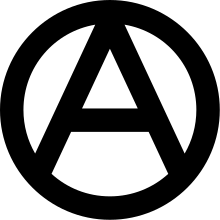Anarchism in Venezuela
Anarchism in Venezuela has historically played a fringe role in the country's politics, being consistently smaller and less influential than equivalent movements in much of the rest of South America. It has, however, had a certain impact on the country's cultural and political evolution.
History
Between the late 19th century and the first third of the 20th century, the most active period in the region's anarchist history, there were few Venezuelan anarchists. There were, however, a somewhat significant number of local intellectuals who were at least influenced by the ideology's theorists.[1] Among them were Ezequiel Zamora (1817-1860), a Liberal politician and prominent rebel leader during the Federal War, who is said to have been influenced by among others Pierre-Joseph Proudhon. The 2001 land reform program Mission Zamora was named after him.[1][2]
One reason behind the weakness of the early anarchist movement was the regime of Juan Vicente Gómez, who ruled Venezuela both as elected president and unelected military strongman between 1908 and 1935. Gómez extensively persecuted rivals, political dissidents, and trade unionists. Among the later victims were members of a nascent anarcho-syndicalist movement, belonging to an ideology brought in by radical immigrants from Europe. While they were few in numbers, the efforts of these people in forming mutual societies, organizing oil industry strikes, spreading propaganda, etc. gained them a certain notoriety, but also the full attention of Gómez's persecution.[3]
Some early communists had anarchist influences - Pío Tamayo (1898-1935), a revolutionary poet and co-founder of the Communist Party of Venezuela, taught his fellow political prisoners the "socialism of Bakunin and Marx". Tamayo, who died in prison, was imprisoned by Gómez.[4] Another political prisoner during this period was the Colombian individualist anarchist Biofilo Panclasta (1879–1943), who participated in the "Revolución Liberal Restauradora" of Cipriano Castro, aiding in the overthrow of President Ignacio Andrade, prior to his encounter of anarchist thought. Arrested in 1914 after returning to Venezuela, Panclasta spent seven years in prison, more due to his friendship with Castro (deposed in a coup d'état by Gómez) than for his ideology.[5]
After the end of the Gómez regime, and with the growth of new politicals movements in Venezuela, many libertarian-minded radicals were absorbed by or helped found non-anarchist organizations, as in the case of Pío Tamayo. Like Tamayo, some joined the Communist Party of Venezuela. Others were among the founders of the Democratic Action in 1941. Between 1936 and 1945, anti-anarchist repression had a constitutional footing, in the form of the Ley Lara (Lara Law).
After the Spanish Civil War, many exiled anarchists arrived in Venezuela, finding a political climate far different from that of interwar Spain. This second wave of anarchist European immigrants caused the regrowth of the small libertarian scene, primarily through the foundation of the Federación Obrera Regional Venezolana (FORVE, Venezuelan Regional Workers Federation) in 1958, after ten years of harsh military dictatorship. FORVE was affiliated with the International Workers' Association, a global anarcho-syndicalist movement founded in 1922. Some additional minor groups were formed, and newspapers, pamphlets and books were published, but few of these left the Spanish immigrant milieu.
In later years, as the ageing Spanish Civil War veterans diminished in importance, few movements would associate with the anarchist label. Some libertarian influence was seen among students in the Renovación Universitaria (University Renewal) of 1968-1970, part of the Protests of 1968. It wasn't until the 1980s that anarchist movements again resurfaced - the Colectivo Autogestionario Libertario (CAL. Libertarian Self-managing Collective) was the most visible. Two journals, El Libertario (published by CAl 1985-87) and Correo A (published 1987-1995) emerged. Some youths were drawn in through anarcho-punk. The Cuban anarchist editorial collective Guángara had correspondents in Venezuela, by 1985. Prominently, the Argentine anarchist philosopher and university professor Ángel Cappelletti (1927–1995) worked in Venezuela for 26 years, until his retirement in 1994.[6]
Contemporary
In 1995 the newspaper El Libertario reappeared, published by a group calling itself the Commission of Anarchist Relations (CRA). The CRA, which restyled itself the Collective Editorship in 2007, opposes the Chavismo and Bolivarian Revolution of former President Hugo Chávez, the Fifth Republic Movement, and its successor the United Socialist Party of Venezuela. The group sees itself as involved in a "tri-polar struggle" against both the left-wing government and Venezuela's American-backed right-wing opposition movement. El Libertario publishes five editions yearly. Other minor groups exist or have existed, such as the CESL in Caracas, the CEA in Mérida, and the Ateneo La Libertaria, first active in Biscucuy and then in the rural area to the southwest of Lara. In January 2006 the Alternative Social Forum was organized in Caracas, and the Anarchist Black Cross has been somewhat active in the country.
In 2011, the minor Federación Anarquista Revolucionaria de Venezuela (FARV) was formed. Unlike the CRA and El Libertario, the group took firmly pro-Boliviarian stances, stating that it supported the "Bolivarian process critically as radical militants of the Social revolution". Their ideas and principles were "based on the especifist trend within libertarian communism".[7]
In October 2013, Chávez's successor, President Nicolás Maduro, accused unionist workers of the SIDOR steel company of being behind regional unemployment, denouncing them as "anarcho-syndicalist populists".[8]
References
- Capelletti, Angel; Rama, Carlos M. (1990). El anarquismo en América Latina (in Spanish). Caracas: Biblioteca Ayacucho. pp. 94–98. ISBN 980-276-116-8.
- Brito Figueroa, Federico (1981). Tiempo de Ezequiel Zamora (in Spanish). Caracas: U. Central Venezuela - EBUC.
- Rodríguez, L. (1993). Conociendo al Anarcosindicalismo Venezolano. Caracas: Correo A. pp. 16–17.
- Sananes, M. (1987). Pío Tamayo, una Obra para la Justicia, el Amor y la Libertad (in Spanish). Caracas.
- Panclasta, Biofilo (2013). Seven Years Buried Alive & Other Writings. Seattle: Ritmomaquia.
- Méndez, N.; Vallota, A. (2001). Bitácora de la Utopía (in Spanish). Caracas: Universidad Central de Venezuela.
- "Manifesto of the Federación Anarquista Revolucionaria de Venezuela (FARV)". Anarkismo.net. Federación Anarquista Revolucionaria de Venezuela. 10 October 2011.
- "Maduro responsabilizó a "anarco-sindicalistas" por paro en Sidor". El Universal (in Spanish). Caracas. 5 October 2013. Retrieved 31 August 2014.
